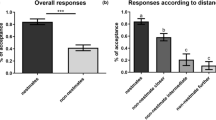Abstract
A laboratory study is presented which shows that larval foraging behavior in the sibling speciesDrosophila melanogaster andD. simulans can respond rapidly (in six generations) to unidirectional selection. An apparatus was designed which selected for larvae which moved from nonnutritive agar medium to plugs of nutritive medium and remained feeding there. Larvae of the selected lines showed a correlated decrease in foraging path length which mirrored thesitter larval forager behavior type previously defined by Sokolowski [(1980).Behav. Genet. 10:291–302]. This supported the hypothesis that sitter larvae moved toward, and remained feeding on, a food source when they were not already utilizing one, whereasrover larvae foraged from food patch to food patch.
Similar content being viewed by others
References
Bakker, K. (1961). An analysis of factors which determine success in competition for food among larvae ofDrosophila melanogaster.Arch. Neerl. Zool. 14:200–281.
Bakker, K. (1969). Selection for rate of growth and its influence on competitive ability ofDrosophila melanogaster.Neth. J. Zool. 19:541–595.
Kawanishi, M., and Watanabe, T. K. (1978). Difference in photo-preferences as a cause of coexistence ofDrosophila simulans andD. melanogaster in nature.Jap. J. Genet. 53:209–214.
McKenzie, J. A., and McKechnie, S. W. (1979). A comparative study of resource utilization in natural populations ofDrosophila melanogaster andD. simulans.Oecologic 40:299–309.
Moth, J. J., and Barker, J. S. F. (1977). Interspecific competition betweenDrosophila melanogaster andDrosophila simulans: Effects of adult density on adult viability.Genetics 47:203–218.
Ohnishi, S. (1979). Relationship between larval feeding behavior and viability inDrosophila melanogaster andDrosophila simulans.Behav. Genet. 9:129–134.
Parsons, P. A. (1975). The comparitive evolutionary biology of the sibling species,Drosophila melanogaster andD. simulans.Q. Rev. Biol. 50:151–161.
Parsons, P. A. (1977). Genes, behavior, and evolutionary processes: The genusDrosophila.Adv. Genet. 19:1–32.
Sokolowski, M. B. (1980). Foraging strategies ofDrosophila melanogaster: A chromosomal analysis.Behav. Genet. 10:291–302.
Sokolowski, M. B., and Hansell, R. I. C. (1983).Drosophila larval foraging behavior. I. The sibling species,D. melanogaster andD. simulans.Behav. Genet. 13:159–168.
Tantawy, A. O., Mourad, A. M., and Masry, A. M. (1970). Studies on natural populations ofDrosophila. VII. A note on the directional changes over a long period of time in the structure ofDrosophila near Alexandria, Egypt.Am. Nat. 104:105–109.
Watanabe, T. K., and Kawanishi, M. (1976). Colonization ofDrosophila simulans in Japan.Proc. Jap. Acad. 52:191–194.
Author information
Authors and Affiliations
Additional information
This research was supported by an NSERC Graduate Fellowship and the University of Toronto Open Fellowship to M. B. Sokolowski and NSERC Operating Grant N505 to R. I. C. Hansell.
Rights and permissions
About this article
Cite this article
Sokolowski, M.B., Hansell, R.I.C. & Rotin, D. Drosophila larval foraging behavior. II. Selection in the sibling species,D. melanogaster andD. simulans . Behav Genet 13, 169–177 (1983). https://doi.org/10.1007/BF01065665
Received:
Accepted:
Issue Date:
DOI: https://doi.org/10.1007/BF01065665




